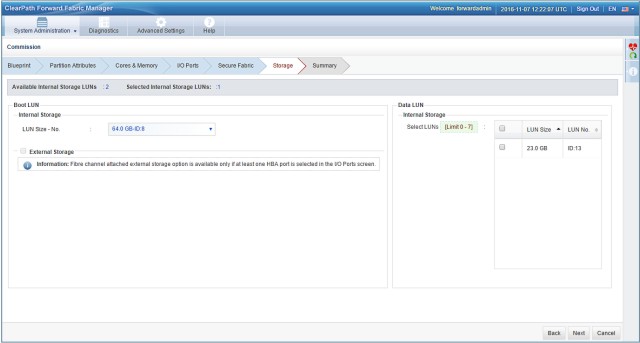When you order hardware for a ClearPath Forward fabric, you choose how many SAS disk drives you want each enterprise partition platform (EPP) to include.
The overall physical storage of a partitionable EPP’s SAS disks is divided into logical virtual disks, in order to provide flexibility in allocating storage space. These virtual disks can then be assigned to the various partitions on the platform as desired. Virtual disks are identified by logical unit numbers (LUNs).
Each partition (both enabled and disabled) can have a maximum of one boot disk LUN assigned to it from a RAID group of internal disks.
Each partition (both enabled and disabled) can have a maximum of eight data LUNs assigned to it from a RAID group of internal disks.
The base configuration consists of two, three, or four 300 GB HDD storage drives (depending on EPP type) configured as a single RAID group. There are 11 user LUNs in this RAID group (and another 5 dedicated to usage by s-Par® firmware).
When the ClearPath Forward product is first installed at your site, the Unisys service representative will consult with you to determine how you want to divide up each partitionable EPP’s available physical disk storage space into virtual disk storage space for your partitions. That is:
How many LUNs you desire
One boot LUN per partition image boot volume
Up to eight data LUNs per partition
The size of each LUN
The following screen is used during commissioning.

Minimum required LUN sizes depend on a number of factors, including operating system vendor requirements, operating system and application configurations in the blueprint and gold image, and partition memory configuration. Refer to Windows and Linux documentation and any special requirements for the specific blueprint to determine the recommended LUN size. The following are guidelines for minimum LUN sizes:
Windows: 60 GB. If your partition image has been configured with large amounts of memory (for example, 3 TB), 110 GB is preferable.
Linux: 20 GB. If your partition image has been configured with large amounts of memory (for example, 3 TB), a larger LUN size might be needed.
See Overview of Partition Planning for information on how to determine LUN size.
Naturally, the storage size available for user virtual disks (LUNs) varies depending on the number of physical disks.
This release supports up to 30 enabled partition images (depending on the EPP type). However, because s-Par consumes 5 LUNs, there are only 11 user LUNs available in the base configuration RAID group. Therefore, to support 30 enabled partition images (or any combination of enabled and disabled partition images exceeding 11), you must have multiple RAID groups.